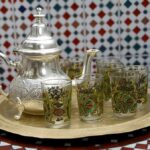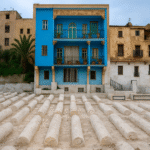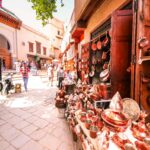
Chebakia: Exploring the Captivating Moroccan Pastry
Morocco is famous for its delicious food, and one dessert stands out. This traditional Moroccan dessert is loved by many. It’s a key part of celebrations, showing the country’s warm welcome.
The pastry is shaped into beautiful designs. It’s not just tasty but also a visual delight. It holds deep meaning in Moroccan culture, telling stories of the past.
Let’s dive into the world of this amazing pastry. We’ll look at what it’s made of, how it’s made, and its role in Moroccan celebrations.
The Allure of Chebakia in Moroccan Cuisine
Chebakia in Moroccan cuisine is special for many reasons. It’s not just about its tasty flavor. It also holds deep cultural and historical value. This traditional pastry is a favorite in many homes, especially during big celebrations.
Chebakia is loved for its crunchy texture and sweet aroma. Making it is hard work. It involves layering dough, frying, and soaking it in honey. This gives it a unique taste and feel.
In Moroccan cuisine, Chebakia is more than a sweet treat. It’s a sign of welcome and community. At weddings and holidays, it’s given to guests as a gesture of respect and warmth. It shows the host’s kindness and the community’s bond.
The making of Chebakia is a family tradition. It brings together generations. They share recipes and techniques, keeping the tradition alive.
In short, Chebakia’s charm in Moroccan cuisine comes from its taste, cultural importance, and its role in uniting people. It’s a beloved pastry in Moroccan traditions, enjoyed on special days and everyday treats alike.
The Rich History of Chebakia
Chebakia is a pastry deeply rooted in Moroccan culture. It has a rich history that spans centuries. This traditional dessert is a staple in Moroccan cuisine, especially during special occasions and celebrations.
The origins of Chebakia are complex. They were influenced by the cultural and culinary traditions of various civilizations. The dessert is believed to have been inspired by the ancient culinary practices of the Mediterranean region, with influences from Arabic, Berber, and other cultural traditions.
Over time, Chebakia has evolved to become an integral part of Moroccan culinary identity. The pastry’s preparation and ingredients have been refined and adapted to local tastes. This resulted in a unique flavor profile that is both sweet and aromatic.
The historical significance of Chebakia is also reflected in its association with Moroccan celebrations and traditions. In many Moroccan communities, Chebakia is a symbol of hospitality and generosity. It is often served to guests during special occasions such as weddings and holidays.
The evolution of Chebakia is a testament to the dynamic nature of culinary traditions. As Moroccan cuisine continues to evolve, Chebakia remains a beloved dessert. It is cherished for its rich history and cultural significance.
Throughout its history, Chebakia has been shaped by various cultural influences. This resulted in a unique and delicious traditional sweet. Its enduring popularity shows the importance of preserving culinary heritage and cultural traditions.
Understanding the Authentic Chebakia
At the heart of every authentic Chebakia lies a delicate balance of traditional ingredients. The pastry’s uniqueness is deeply rooted in its components. These components work together to create its distinctive flavor and texture.
Flour, Sesame Seeds, and Anise: The Foundation
The foundation of Chebakia is built around flour, sesame seeds, and anise. Flour gives the pastry structure. Sesame seeds add a nutty flavor and crunchy texture. Anise, with its distinct licorice flavor, complements the sesame seeds and contributes to the pastry’s aromatic profile.
The quality of the ingredients is paramount. High-quality sesame seeds make a significant difference in the flavor and texture of Chebakia. Using appropriate spices and fresh anise ensures the pastry is fragrant and flavorful.
Honey, Orange Blossom Water, and Spices: The Flavor Profile
The flavor profile of Chebakia is further enhanced by honey, orange blossom water, and a blend of spices. Honey adds a touch of sweetness. Orange blossom water provides a floral and fragrant note. The spices, including cinnamon and other traditional Moroccan spices, add depth and warmth to the pastry.
The use of orange blossom water is particularly significant. It gives Chebakia its distinctive and exotic flavor. The balance between the sweetness of the honey and the fragrance of the orange blossom water is key to the pastry’s unique taste. The spices play a crucial role in tying the various flavors together, creating a harmonious and complex flavor profile.
In conclusion, the authenticity of Chebakia is deeply rooted in its traditional ingredients and their quality. Understanding these components is essential to appreciating the pastry’s unique characteristics and flavor profile.
The Art of Making Traditional Chebakia
Making traditional Chebakia is an art that needs precision, patience, and a deep love for Moroccan cooking. It involves many steps, from making the dough to frying and coating it in honey. To make perfect Chebakia, one must focus on details and follow traditional methods passed down through generations.
The dough for Chebakia is made from flour, sugar, and spices. These ingredients are mixed and kneaded until smooth. Then, the dough is rested and rolled out into thin sheets.
Shaping Chebakia is where the real skill is. Hand-folding techniques are key to creating its unique layers and patterns. The dough is folded and shaped with great care to get the right layers.
Hand-Folding Techniques
The hand-folding technique is about folding the dough into beautiful patterns, like flowers or shapes. This makes Chebakia look good and adds to its texture when fried. Getting good at these techniques is crucial for making great Chebakia.
Common Shaping Mistakes to Avoid
When shaping Chebakia, it’s easy to make mistakes that can ruin the quality. One common error is applying too much pressure, which can tear the dough. Another mistake is not evenly coating the layers with spices, leading to uneven flavors.
To avoid these mistakes, it’s important to work slowly and consistently. This way, you’ll get Chebakia that looks great and tastes amazing.
The last steps are frying the pastries until they’re golden and then coating them in honey syrup. Frying needs careful attention to oil temperature to get the right crispiness without burning the pastry.
In conclusion, making traditional Chebakia is a detailed process that requires patience and a focus on tradition. By mastering hand-folding techniques and avoiding common mistakes, anyone can make authentic Chebakia that respects Moroccan culinary traditions.
Regional Variations of Chebakia Across Morocco
Traveling across Morocco shows the rich diversity in Chebakia recipes. This traditional pastry is a big deal during Ramadan. Each region has its own way of making it, showing off local tastes and ingredients.
In the north, Chebakia is made with local honey and almonds. This gives it a special flavor and texture. Honey makes it taste richer, and almonds add crunch. In the south, dates or date syrup are used, reflecting the area’s date abundance.
How Chebakia is made also changes from place to place. Some areas fry it until it’s crispy, while others bake it for a softer texture. The spice blend can vary too, with some adding cinnamon or nutmeg for a unique taste.
These differences make Chebakia a fascinating dish to explore. Each region puts its own spin on this traditional pastry. This shows the variety in Moroccan cuisine.
The variety in Chebakia recipes across Morocco highlights the country’s rich food heritage. It shows how Moroccan cuisine is adaptable and creative, blending tradition with local flair.
Chebakia in Moroccan Celebrations and Traditions
Chebakia is more than a pastry in Moroccan culture. It’s a symbol of tradition and community. This sweet treat is key in Moroccan celebrations, especially during Ramadan.
The Iftar Table and Chebakia’s Role
During Ramadan, the fast is broken at Iftar. Chebakia is a must-have on the Iftar table. Its honey-soaked layers and sesame seeds offer a sweet end to the fast.
Families come together, and Chebakia is often the first thing eaten after dates and traditional tea. It’s not just about food; it’s a celebration of the day’s end and a time to bond with loved ones.
Making Chebakia for Iftar is a family affair, involving generations. It’s a way to bond and share stories and recipes. This tradition highlights Chebakia’s role in Moroccan culture, making it a key part of Iftar.
Community and Family Traditions
Chebakia is also part of community and family traditions in Morocco. It’s made in large quantities, to share with neighbors, friends, and those in need. This act of sharing strengthens community bonds and shows Moroccan values of hospitality and generosity.
In many Moroccan homes, making Chebakia is a family activity. It involves kneading dough, shaping the pastry, and frying it to perfection. This shared effort creates memories and keeps a tradition alive in Moroccan culture.
Chebakia’s role in Moroccan celebrations and traditions is deep. It symbolizes community, brings people together, and is a key part of Moroccan culture. So, Chebakia remains a vital part of Moroccan identity, especially during celebrations and times of togetherness.
Nutritional Profile and Modern Adaptations
Chebakia’s nutritional profile and modern twists are exciting for food lovers. It’s made with flour, nuts, and honey. These ingredients offer carbs, proteins, and fats.
Chebakia is rich in calories but can be a healthy snack in small amounts. Nuts like almonds or walnuts add healthy fats and antioxidants. This makes Chebakia a nutritious choice.
Healthier Alternatives and Substitutions
Modern recipes make Chebakia healthier by swapping ingredients. Using whole wheat flour boosts fiber. Cutting down sugar or using honey or maple syrup lowers the sugar content.
Toasting nuts enhances their taste, reducing the need for extra sugar or oil. Some recipes add sesame or chia seeds. This adds more nutrients and texture.
Fusion Flavors and Modern Interpretations
Chebakia’s versatility leads to new flavors and interpretations. Chefs and home cooks try different ingredients for unique Chebakias. Adding spices like cinnamon or cardamom gives it a special taste.
Modern Chebakias might use different sweeteners or dried fruits like cranberries or apricots. These changes attract more people to try Chebakia. They make it appealing to a wider audience.
Chebakia stays vibrant and evolving in Moroccan cooking. It blends traditional methods with new ideas.
Pairing and Serving Suggestions
Chebakia is more than just a treat; it’s about how you enjoy it. It’s often paired with Moroccan tea. This combination is both culturally rich and tasty.
Moroccan tea, made with green tea, fresh mint, and sugar, is a perfect match. The art of making Moroccan tea is a cherished tradition. Paired with Chebakia, it offers a genuine Moroccan experience.
But you can also try Chebakia with coffee or fruit juices. Yet, Moroccan tea is the top choice. The tea’s bitterness balances the honey’s sweetness, making it a delightful mix.
In today’s world, Chebakia can be paired with many desserts or snacks. For example, serving it with Moroccan pastries or dried fruits adds to the cultural flavor. It makes the experience even more special.
Don’t forget about presentation. Traditionally, Chebakia is placed on fancy plates or trays, often with nuts or dried fruits. This makes it not only look good but also feel like a special treat.
Finding Authentic Chebakia in the United States
Looking for authentic Chebakia in the US is a fun food journey. You can find it in local bakeries or online. There are many ways to try this traditional Moroccan pastry.
Visiting Moroccan bakeries in big cities like New York or Los Angeles is a great idea. These places use traditional ingredients and recipes. This way, you get a true taste of Chebakia.
If you can’t find Moroccan bakeries, online recipes are a good option. Many websites and blogs have guides on making Chebakia. You can follow along and make it yourself, even if it’s not perfect.
Online shopping also helps get authentic ingredients for Chebakia. Even if you’re far from Moroccan communities, you can find what you need. This makes making Chebakia at home easier.
In summary, finding authentic Chebakia in the US might take some effort. But with Moroccan bakeries, online recipes, and ingredients, it’s possible. Anyone can enjoy this tasty Moroccan treat.
Preserving the Legacy of Chebakia for Future Generations
Chebakia is a key part of Moroccan culture. It’s important to keep it alive for the next generations. We can do this by cooking and sharing traditional recipes.
Keeping Chebakia alive means more than just recipes. It’s about the culture and traditions behind it. By preserving this, we keep its history and importance alive.
There’s a growing interest in Moroccan cuisine, especially among young people. They’re learning and trying out traditional recipes. This is a great sign for preserving Chebakia’s cultural heritage.











I do not know if it’s just me or if everybody else experiencing issues
with your website. It seems like some of the text within your posts are running off the screen. Can somebody else please provide
feedback and let me know if this is happening to them as well?
This could be a issue with my internet browser because I’ve had this happen before.
Thanks
I’m gone to inform my little brother, that he
should also go to see this blog on regular basis to take updated from
most up-to-date news update.